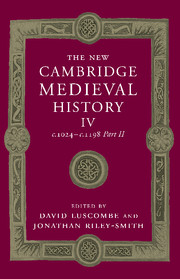Book contents
- Frontmatter
- 1 Introduction
- 2 The papacy, 1024–1122
- 3 The western empire under the Salians
- 4 Italy in the eleventh century
- 5 The kingdom of the Franks to 1108
- 6 Spain in the eleventh century
- 7 England and Normandy 1042–1137
- 8 The Byzantine Empire, 1025–1118
- 9 Kievan Rus’, the Bulgars and the southern Slavs, c. 1020 – c. 1200
- 10 Poland in the eleventh and twelfth centuries
- 11 Scandinavia in the Eleventh and Twelfth Centuries
- 12 Hungary in the Eleventh and Twelfth Centuries
- 13 The papacy, 1122–1198
- 14 The western empire, 1125–1197
- 15 Italy in the twelfth century
- 16 Spain in the twelfth century
- 17 The kingdom of the Franks from Louis VI to Philip II
- 18 England and the Angevin dominions, 1137–1204
- 19 Scotland, Wales and Ireland in the Twelfth Century
- 20 The Byzantine Empire, 1118–1204
- 21 The Latin East, 1098–1205
- 22 ’Abbasids, Fatimids and Seljuqs
- 23 Zengids, Ayyubids and Seljuqs
- Appendix: genealogical tables
- List of primary sources
- Bibliography of Secondary Works Arranged by Chapter
- Index
- Map 1a The western empire: Burgundy and Provence in the eleventh century"
- Map 1b The western empire: Germany and the north-eastern frontier of Christendom in the eleventh century"
- Map 3 The kingdom of the Franks"
- Map 4 England and Normandy"
- Map 10 Germany under Frederick Barbarossa, c. 1190">
- Map 12 The Angevin empire"
- References
10 - Poland in the eleventh and twelfth centuries
Published online by Cambridge University Press: 28 March 2008
- Frontmatter
- 1 Introduction
- 2 The papacy, 1024–1122
- 3 The western empire under the Salians
- 4 Italy in the eleventh century
- 5 The kingdom of the Franks to 1108
- 6 Spain in the eleventh century
- 7 England and Normandy 1042–1137
- 8 The Byzantine Empire, 1025–1118
- 9 Kievan Rus’, the Bulgars and the southern Slavs, c. 1020 – c. 1200
- 10 Poland in the eleventh and twelfth centuries
- 11 Scandinavia in the Eleventh and Twelfth Centuries
- 12 Hungary in the Eleventh and Twelfth Centuries
- 13 The papacy, 1122–1198
- 14 The western empire, 1125–1197
- 15 Italy in the twelfth century
- 16 Spain in the twelfth century
- 17 The kingdom of the Franks from Louis VI to Philip II
- 18 England and the Angevin dominions, 1137–1204
- 19 Scotland, Wales and Ireland in the Twelfth Century
- 20 The Byzantine Empire, 1118–1204
- 21 The Latin East, 1098–1205
- 22 ’Abbasids, Fatimids and Seljuqs
- 23 Zengids, Ayyubids and Seljuqs
- Appendix: genealogical tables
- List of primary sources
- Bibliography of Secondary Works Arranged by Chapter
- Index
- Map 1a The western empire: Burgundy and Provence in the eleventh century"
- Map 1b The western empire: Germany and the north-eastern frontier of Christendom in the eleventh century"
- Map 3 The kingdom of the Franks"
- Map 4 England and Normandy"
- Map 10 Germany under Frederick Barbarossa, c. 1190">
- Map 12 The Angevin empire"
- References
Summary
by the eleventh century the formation of a strong monarchy on the compact territory of the Odra and the Vistula river-basins, extending south as far as the Sudetes and the Carpathian Mountains, and north as far as the Baltic Sea, had been completed; the process of Christianization was well advanced, and Poland could already boast her own saint in the person of Bishop Wojciech (Adalbert) of Prague, who had been exiled from Bohemia; the Polish rulers had established good relations with the western empire and had developed contacts with distinguished personages of the time. In the year 1000 the emperor Otto III arrived in Poland to elevate Gniezno (Gnesen) to the level of archbishopric, thus creating the first Polish ecclesiastical province, to which the apostolic see had given its consent earlier. The ruler of Poland, Prince Boleslaw Chrobry (Boleslaw the Brave) of the Piast dynasty, managed to win Otto’s trust by supporting his project of the ‘revival of the Roman empire’ and was called ‘an aide’ (cooperator) of the empire, in which, it seems, he stood a good chance of representing one of its four basic territorial parts (Roma, Galia, Germania, Sclavinia). But the death of Otto III in 1002 and the changes in German policy under Henry II on the one hand and Boleslaw’s expansive plans towards Milsko (Milzi), Łużyce (Lusatia) and Bohemia on the other led to a long Polish-German war, which was fought in three stages (1003–5, 1007–13,1015–17) and ended with a peace treaty in Budziszyn (Bautzen) in 1018.
- Type
- Chapter
- Information
- The New Cambridge Medieval History , pp. 277 - 289Publisher: Cambridge University PressPrint publication year: 2004
References
- 1
- Cited by

